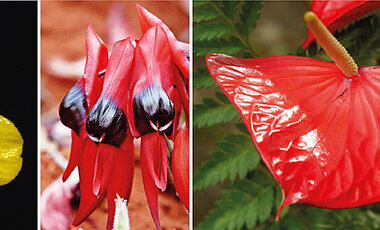The paradox of the shiny flowers
22.11.2022Dr. Casper van der Kooi is a guest at the University of Würzburg as a Humboldt Fellow. For one year he will be researching the color tricks of certain flowers at the Department of Zoology II.

Red, yellow, purple, blue: nature offers an amazing variety of flower colors. The purpose behind this diversity is clear: These colors have evolved to attract pollinating insects, which are essential for plant reproduction. Yet the vast majority of flower colors are dull - that is, the color of these flowers is the same from any angle.
"Interestingly, however, numerous plant species have evolved flowers that have a glossy appearance. A typical Western European example is the buttercup flower, but there are also glossy orchids and tulips," explains Dr. Casper van der Kooi. The biologist has recently started as an Alexander von Humboldt Fellow a at the University of Würzburg. Equipped with a research grant for experienced researchers, he will spend the next twelve months at the chair of Professor Wolfgang Rössler together with Dr. Johannes Spaethe to investigate how this shine influences the visibility of a flower for insects.
A flash of light that can confuse
"Shiny flowers produce a bright pulse of light when viewed from a certain angle," Van der Kooi explains. For humans, he says, this flash effect is clearly perceptible; it is as yet unclear whether insects can also perceive this flash - after all, their visual system is very different from that of humans. "The fact that numerous plants have independently evolved shiny flowers suggests that under certain conditions it is advantageous to be shiny," the biologist says. But when and how that is the case has not yet been studied in detail, he adds.
Over the next few months, Van der Kooi and Spaethe therefore plan to investigate how gloss influences the visibility of a flower to insects. In a series of behavioral experiments, the two will explore whether and how bumblebees perceive this effect. Their hypothesis is that the flash effect increases a flower's visibility from a distance, comparable to a lighthouse whose beam can be seen from a great distance. However, they also hypothesize that the flashing effect at close range can blind and confuse bees.
Basic insights into flower signaling
Since his student days, Van der Kooi has been interested in how flowers get their colors and how those colors evolved in the eyes of pollinators. He has already published several papers on the optical properties of flowers, but this Humboldt project allows him to go one step further. "During my time at the University of Würzburg, I want to gain experience on how to use behavioral experiments to study how visual signals trigger a response in insects and how these signals are perceived and processed by the species-specific sensory system." He said he was particularly excited about working on flower gloss, because he had already studied the optical properties of buttercup flowers during his undergraduate studies.
According to the two biologists, the results of the project will provide "fundamental insights into flower signaling." After this project, they hope, it will be possible to understand how bees perceive useful information from the complex natural world and how they respond to dynamic color signals. In addition, they will be the basis for future work in a variety of fields - both basic and applied research, such as plant breeding and agriculture.
About the person
Dr. Casper van der Kooi studied biology (bachelor) at the University of Groningen (The Netherlands) from 2008 to 2012. In 2014, he completed his Master's degree in "Ecology and Evolutionary Biology", and in 2015 he received his PhD with a thesis in Computational Physics and Plant Physiology. From 2014 to 2018, he conducted research at the University of Lausanne (Switzerland). Since 2018, Van der Kooi is head of a research group at the University of Groningen.
Contact
Dr. Casper van der Kooi, Chair of Behavioral Physiology and Sociobiology, c.j.van.der.kooi@rug.nl
Links
Paper on the optical properties of buttercups
Paper in Science by Casper van der Kooi and colleagues on the origin of flowers and pollination







